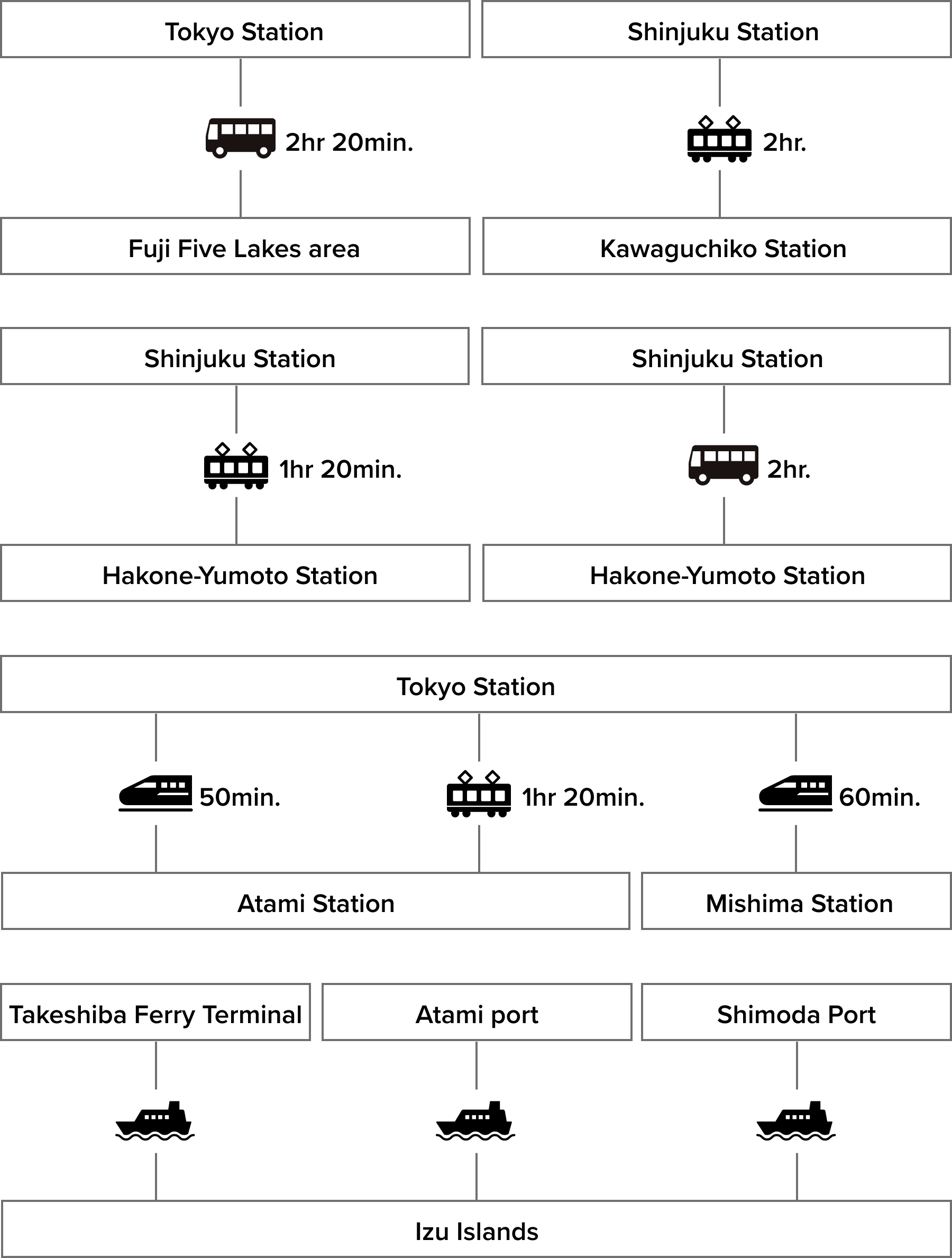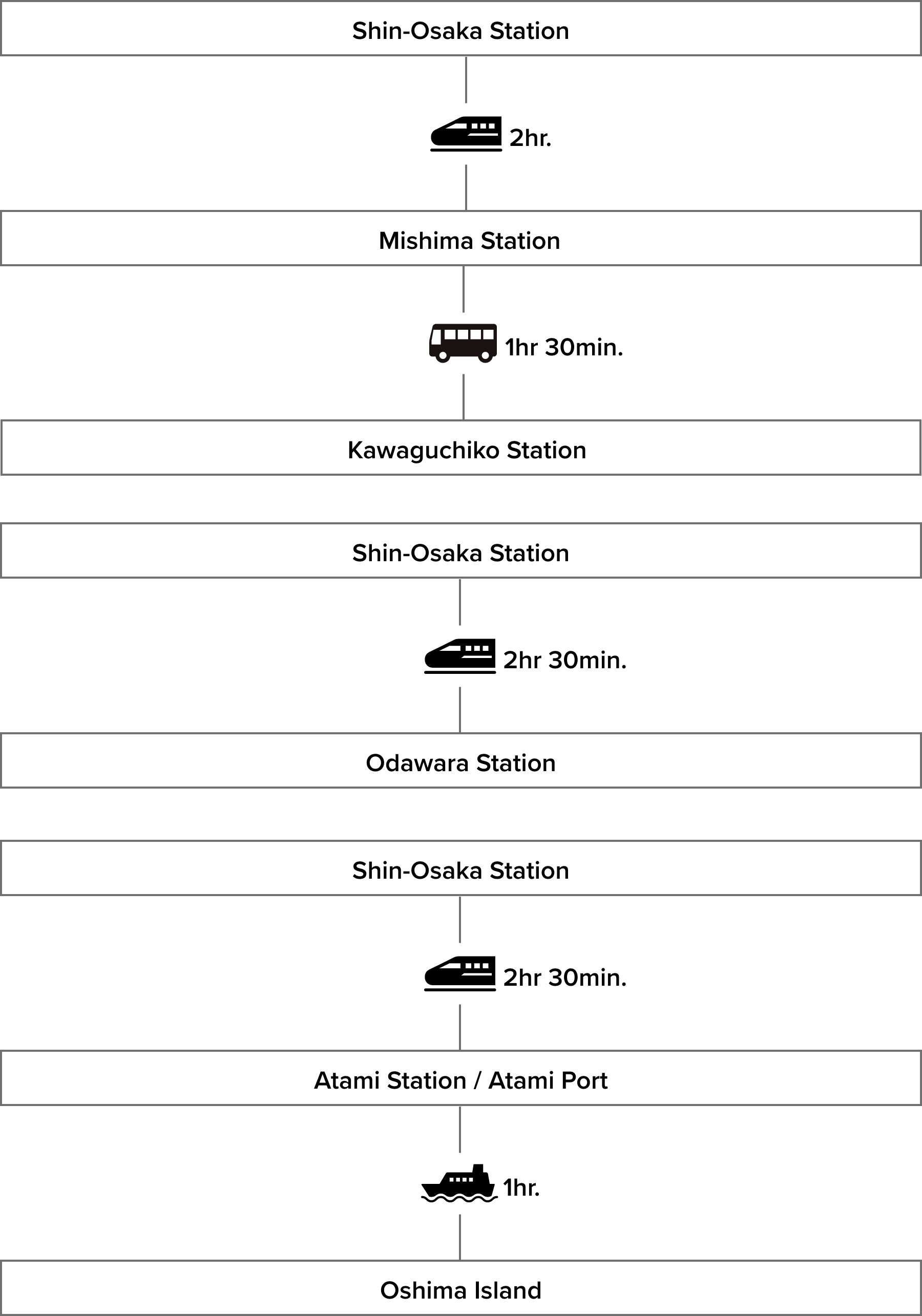| From Tokyo: | 2-5 hr |
| From Osaka: | 3.5-6 hr |
How to Get There
Fuji-Hakone-Izu National Park contains some of Japan’s most celebrated destinations. The park—which encompasses parts of Yamanashi, Shizuoka and Kanagawa prefectures, as well as Tokyo—can be separated into four areas: Mount Fuji and its scenic surroundings, the Hakone hot-springs area, Izu Peninsula, and the Izu Islands. There are many transportation options to visit the most popular sites, but you'll need a car to go off the beaten track.
From Tokyo
The Fuji Five Lakes area offers excellent panoramas of the lakes and iconic Mount Fuji. The easiest route from various areas of Tokyo is by highway bus (2 hr 20 min) from companies such as Fujikyuko Bus, Keio Bus, and JR Kanto Bus to Kawaguchiko, the most developed of the lakes. Two direct, limited express trains depart each day from Shinjuku Station to Kawaguchiko Station (2 hr). Hakone, famous for its hot springs, also offers world-class museums and excellent views of Mount Fuji. There are numerous routes from Tokyo, including the direct Odakyu Railway “Romance Car” (1 hr 20 min) that operates between Shinjuku Station and Hakone-Yumoto Station, and the Odakyu Hakone Highway Bus (2 hr). To reach the Izu Peninsula, take the Tokaido Shinkansen to Atami (50 min) or Mishima (50-60 min), or the Odoriko limited express train to Atami (1 hr 20 min). Alternatively, go to Shuzenji via the Sunzu line of the Izu-Hakone Railway, which is a good base point to get around the Izu Peninsula. For a quick jaunt to the Izu Islands, take a Tokai Kisen ferry from Tokyo’s Takeshiba Ferry Terminal or the ports of Atami or Shimoda to Kozujima, Shikinejima, Niijima and Toshima.
Alternatively, there are direct flights from Haneda to Hachijojima.

From Osaka
For the Fujinomiya and Shizouka areas, take the Tokaido Shinkansen to Shinfuji Station where you then have the option of taking a bus to major sites including the Shiraito Falls or Mount Fuji trailhead. For the Yamanashi side, ride the Tokaido Shinkansen to Mishima Station (2 hr) then take a Fujikyu bus to Kawaguchiko Station (1 hr 30 min). To reach the Hakone area, take the Tokaido Shinkansen to Odawara Station (2 hr 30 min) then ride the charmingly retro Hakone Tozan Railway to your preferred destination. The outskirts of the Izu Peninsula are accessible via the Tokaido Shinkansen to Atami or Mishima (2 hr 30 min). To visit Oshima, take the Tokaido Shinkansen to Atami Station (2 hr 30 min) then transfer to a Tokai Kisen ferry at Atami Port (1 hr).

Getting Around
Train and bus networks connect many attractions in Fuji-Hakone-Izu National Park. In the Mount Fuji area, buses depart from the transportation hubs of Kawaguchiko Station and Fujisan Station (both on the Fujikyu Railway Line). Buses include the Omni Bus service that run to lakes Saiko, Shojiko, and Motosuko; Fujikko Bus services that run to spots including Lake Yamanakako; and the Mount Fuji World Heritage Loop Bus for the Kawaguchiko area. For Hakone, the Hakone Free Pass is sold in various combinations and will save you money. The Fuji Hakone Free Pass is a cost-effective way to see both Mount Fuji and Hakone. The Izu Peninsula has an efficient rail and bus network; Izukyu Railways operate all trains south of Ito. Tokai Bus offers special passes to see many of the famous sights, but a rental car will provide the most freedom. Some of the islands have public bus services, but a car or an electronic bike allow better access to some areas.


















